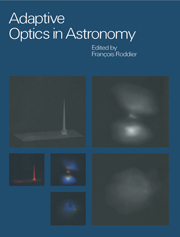Book contents
- Frontmatter
- Contents
- List of contributors
- Part one Introductory background
- Part two The design of an adaptive optics system
- 3 Theoretical aspects
- 4 Wave-front compensation devices
- 5 Wave-front sensors
- 6 Control techniques
- 7 Performance estimation and system modeling
- Part three Adaptive optics with natural guide stars
- Part four Adaptive optics with laser beacons
- Part five The impact of adaptive optics in astronomy
- Glossary of acronyms
- Index
6 - Control techniques
from Part two - The design of an adaptive optics system
Published online by Cambridge University Press: 23 November 2009
- Frontmatter
- Contents
- List of contributors
- Part one Introductory background
- Part two The design of an adaptive optics system
- 3 Theoretical aspects
- 4 Wave-front compensation devices
- 5 Wave-front sensors
- 6 Control techniques
- 7 Performance estimation and system modeling
- Part three Adaptive optics with natural guide stars
- Part four Adaptive optics with laser beacons
- Part five The impact of adaptive optics in astronomy
- Glossary of acronyms
- Index
Summary
An adaptive optics system (AOS) can be defined as a multi-variable servoloop system. Like classical servos, it is made of a sensor, the wave-front sensor (WFS), a control device, the real time computer (RTC), and a compensating device, the deformable mirror (DM). The goal of this servo is to compensate for an incoming optical wavefront distorted by atmospheric turbulence. It is designed to minimize the residual phase variance in the imaging path, i.e. to improve the overall telescope point-spread function (PSF). The input and the output of this servo are respectively the wave front phase perturbations and the residual phase after correction.
The design and the optimization of an AOS is a complex problem. It involves many scientific and engineering topics, such as understanding of atmospheric turbulence, image formation through turbulence, optics, mechanics, electronics, real time computers, and control theory. The goal of this chapter is to provide the basis of spatial and temporal controls. The reader will not find a tutorial on control theory but its application to an AOS. So the reader is assumed to be familiar with classical control theory (see for instance Franklin et al. 1990).
In the following, no restriction is made about the WFS or DM used. The principles are kept unchanged in the case of Shack–Hartmann, curvature sensor, or other WFS, and stacked array, bimorph, segmented DMs, or other wave front compensation devices.
In a first part, the control matrix determination and the modal control analysis of an AOS are described.
- Type
- Chapter
- Information
- Adaptive Optics in Astronomy , pp. 131 - 154Publisher: Cambridge University PressPrint publication year: 1999
- 13
- Cited by



